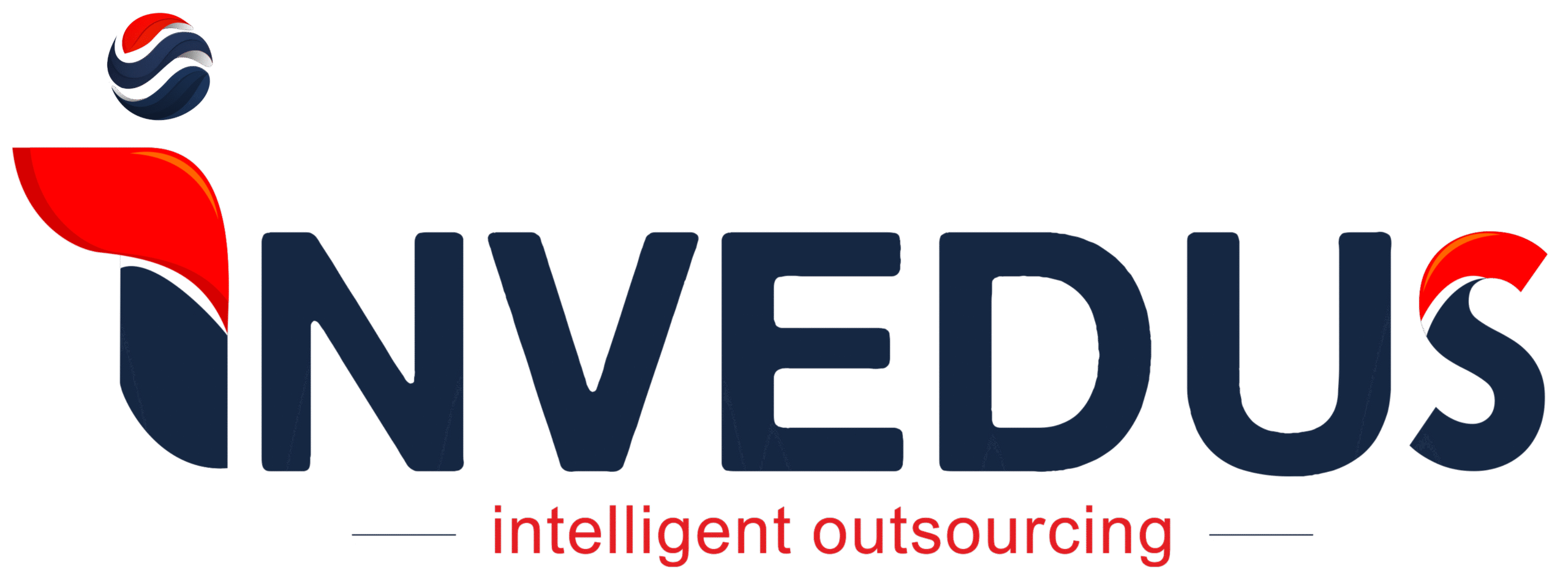
Your Launch-Proof Small Business Checklist – 30 Key Steps: USA + Global Edition
Starting a business can feel like standing at the edge of a cliff: exciting, terrifying, and full of unknowns.
That’s why we created a “Starting a Small Business Checklist”: a no-fluff, 30-step guide designed to walk you through every essential task, from early planning to launch day (and beyond).
Whether you’re building a one-person operation or laying the groundwork for a future team, this checklist combines the best of both worlds:
- A logical, step-by-step guide
- A practical, tick-off-as-you-go list
- Tailored tips for founders in the USA and beyond
Here’s why it matters:
Approximately 20% of new businesses fail within their first year, often due to preventable mistakes like poor planning, legal oversights, or financial missteps.
— Source: sba.gov
We’ve distilled insights from the U.S. Small Business Administration, the IRS, startup experts, and international business portals to give you a clear path forward, without the guesswork.
By the time you hit step 30 in this, you’ll have built something real, legit, and launch-ready. We are pretty sure you’ll bookmark this blog for future reference too.
Let’s break it all down 👇
Stage 1: Planning & Research (Steps 1–7)
“Starting a business without research is like building a house without a blueprint.”
Before you register your business or design a logo, this is the work that makes everything else worth doing. If your foundation isn’t solid, the rest will fall apart, FAST.
1. Define Your Business Idea
Start with clarity: What problem are you solving? Who are you solving it for?
It doesn’t have to be a revolutionary idea; it just needs to be focused and valuable. Too many founders start broad (“I want to sell clothing”) instead of specific (“I want to sell eco-friendly activewear for women over 40”).
💡Start niche. Niching down increases your chances of early traction and cuts through the noise faster.
If you’re unsure, try sketching a Lean Canvas, a one-page framework to summarize your idea, audience, and differentiators. For example, here’s how a lean canvas for a “Remote Mental Health Support Platform for Employees” may look like:
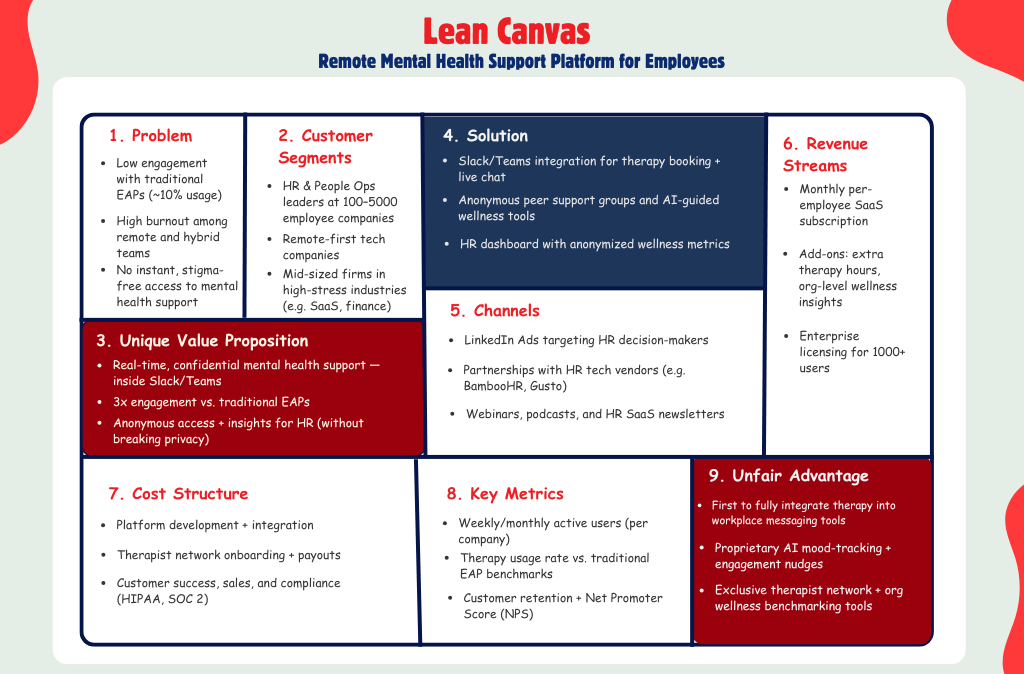
2. Conduct Market Research
Now it’s time to test the waters. Are people actively searching for solutions like yours? How are they currently solving the problem?
Use a mix of tools and tactics:
- Google Trends to check demand over time
- AnswerThePublic or Reddit to understand real-world pain points
- Read Amazon reviews or app store comments for indirect competitors
🎯 Focus on what people complain about, not what they praise; that’s your opportunity window.
Bonus tip: You don’t have to do all this legwork yourself. In our blog, 7 key tasks you can delegate to virtual research assistants, we show how market research can be efficiently outsourced to skilled remote talent without hiring full-time or relying on unpredictable freelancers.
3. Validate the Idea
Don’t skip this. This is where most business ideas quietly die OR sharpen into something viable.
Create a landing page with your offer. Include a CTA like “Join Waitlist” or “Pre-order Now.” Then:
- Share it with niche communities (Facebook groups, Subreddits)
- Spend $50 (or a budget appropriate to your audience) on targeted ads
- Ask 10 strangers (or more, if possible), not friends, what they think
💡 If strangers say, “this solves a real problem,” and a few take action? You’re onto something!
4. Understand Your Target Audience
Your audience is more than demographics. Dig into their motives, pain points, objections, and habits.
Here’s how:
- Interview 5–10 potential users
- Ask:
“What’s your biggest challenge with [X]?”
“How are you solving that now?”
“What would make you switch?”
The words they use are gold: use them in your product copy and marketing later.
5. Analyze the Competition
Search for your product or service idea on Google. Look for:
- Direct competitors (same offer, same market)
- Indirect ones (alternative solutions)
Audit their:
- Pricing
- User experience
- Social proof (reviews/testimonials)
Marketing tone
🧠 Find the gap. Can you be simpler? More transparent? More specific?
Tools like Ubersuggest, Similarweb, and BuiltWith can help you break down their strategy.
6. Choose a Monetisation Model
Will you charge once, monthly, or not at all (freemium)? Will you earn from services, products, subscriptions, or ads?
Ask yourself:
- Is this a one-time or recurring need?
- What are competitors charging, and how?
- Can I test different models easily?
📦 Subscription models bring recurring revenue but only work if your product solves a continuous pain.
If unsure, start simple; flat pricing or a service-based offer lets you validate quickly.
7. Write a Business Plan
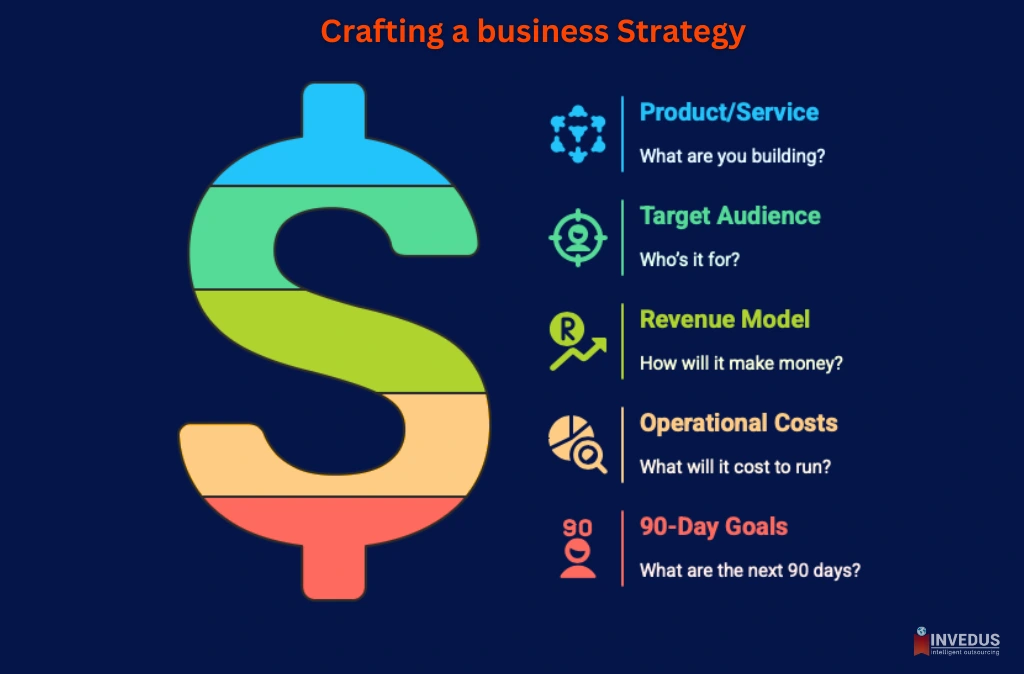
No, you don’t need a 40-page pitch deck. But you do need a plan.
Just cover the basics:
- What are you building?
- Who’s it for?
- How will it make money?
- What will it cost to run?
- What are the next 90 days?
Use a 1-pager or tools like SBA’s Business Plan Builder. Even a structured Notion doc works.
🎯 Your business plan isn’t for investors; it’s for you. Think of it as a confidence roadmap.
Stage 2: Legal and Administrative Setup (Steps 8–15)
“This is the boring but essential part: ignore it, and it can come back to bite you later.”
This is where your business idea becomes real in the eyes of governments, banks, and partners. It’s also where many first-time founders get overwhelmed. Don’t rush this phase; get it right the first time.
8. Choose a Business Name
This is more than just branding; it affects your domain, legal registration, SEO, and even your customer’s first impression.
When brainstorming:
- Choose something easy to spell, say, and remember.
- Check domain availability (use Namechk to scan across platforms).
- Avoid names that are too similar to competitors in your space.
- Do a quick Google and social handle check to avoid surprises.
Before locking it in:
- 🇺🇸 USA: Search the USPTO trademark database and your state’s business name registry
- 🌍 Global: Check your local business registrar and trademark office
💡 Tip: If the .com is taken, consider alternatives like .co, .io, or .ai; just make sure the brand is still uniquely yours.
Here’s how we checked name availability for our example idea (Remote Mental Health Support Platform for Employees) using Namechk:
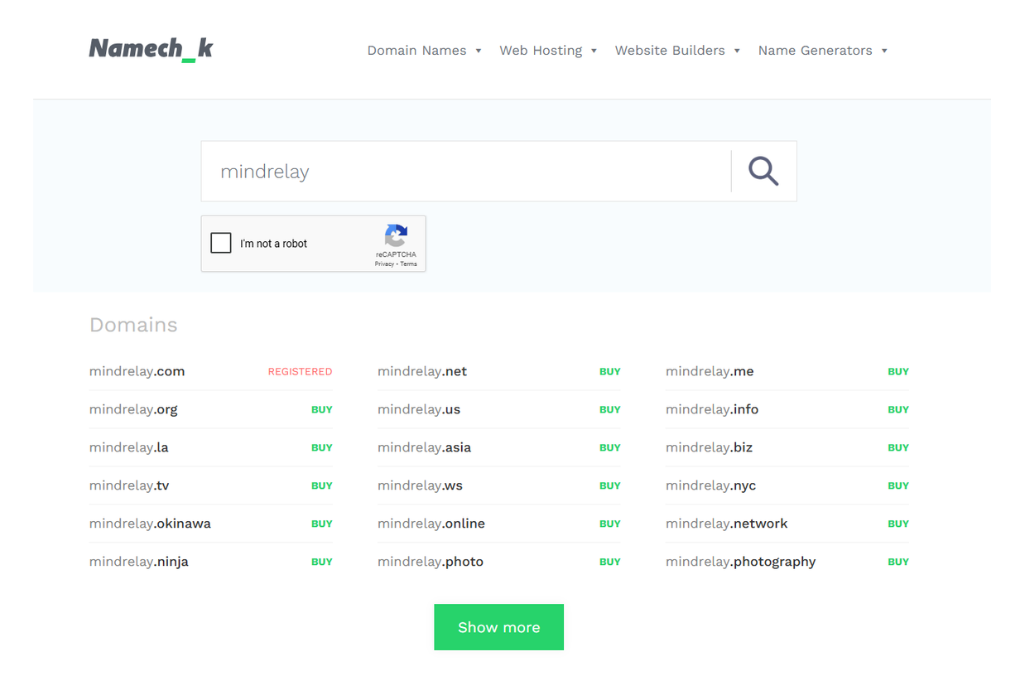
9. Register Your Business
Now that you’ve named your business, it’s time to make it official.
Why it matters:
- Gives you legal recognition
- Enables you to open a business bank account
- Protects your brand (in some regions)
- Required to obtain a tax ID, licenses, and insurance
🇺🇸 USA:
- Register your business with your state’s Secretary of State office
- You may also need to file a DBA (“Doing Business As”) if your business name differs from your personal name
Global examples:
- 🇬🇧 UK: Register your business with Companies House
- 🇨🇦 Canada: Use Corporations Canada
- 🇦🇺 Australia: Register via the ASIC website and obtain your ABN
🧠 Even if you’re a sole proprietor, registration builds trust with clients and protects you from legal headaches later.
10. Decide on a Business Structure
Your structure affects how you’re taxed, how much paperwork you file, and whether your personal assets are protected.
🇺🇸 Common structures:
- Sole Proprietorship: Simple, but no liability protection. Your business and personal assets are legally the same.
- LLC (Limited Liability Company): A popular choice for solo founders and small teams. Flexible taxes and personal asset protection.
- Corporation (C-Corp or S-Corp): Best for startups planning to raise outside funding, but more paperwork and ongoing compliance.
🌍 Global Note:
Terms vary, e.g., sole trader in the UK or private limited company (Ltd). Your country’s tax authority or business registrar usually provides guidance.
💡 Not sure what to pick?
- Starting solo as a coach or consultant? → Sole proprietorship or LLC
- Building a tech product or app? → LLC now, consider converting to Corp later
- Planning to pitch investors soon? → Start with a C-Corp
11. Apply for a Tax ID Number
A tax ID, often called an EIN or business number, legally separates you from your business and is required to:
- Open a business bank account
- Hire employees
- File taxes
- Work with vendors or platforms like Stripe, PayPal, Shopify, Amazon
🇺🇸 USA:
Apply for your EIN at the IRS website. It’s free, takes minutes, and you’ll get your number immediately.
🌍 Outside the US:
You’ll apply for a business number with your local tax authority:
- 🇬🇧 UK: Register for Self Assessment (sole trader) or Corporation Tax (Ltd) with HMRC
- 🇨🇦 Canada: Get your Business Number from the CRA
- 🇦🇺 Australia: Apply for an ABN via business.gov.au
12. Open a Business Bank Account
Mixing personal and business finances is risky and messy.
Here’s why you need a business account:
- Easier bookkeeping
- Cleaner tax records
- Legitimacy with clients, partners, and lenders
- Ability to build business credit
What to look for:
- Low or no monthly fees
- Mobile app + digital banking
- Integrations with tools like QuickBooks, Xero, or Wave
- International founders: Multi-currency accounts like Wise, Payoneer, or Revolut Business can help
🧠 Even if you’re small or just starting out, open this early; it’ll save you headaches later.
13. Get Business Insurance
Most small business owners skip this until they regret it.
The right insurance protects your business from lawsuits, cyber risks, and client disputes.
Here are the essentials:
- General Liability Insurance: Covers physical accidents or damages
- Professional Liability Insurance (E&O): Protects against claims of negligence or errors in services
- Cyber Insurance: Vital for SaaS, e-commerce, or anyone handling user data
- Business Owner’s Policy (BOP): Combines multiple coverages into one package
💡 Cost varies, but many solopreneurs pay around $25–$50/month for basic coverage. Do your own research for ballpark figures.
Providers like Next Insurance, Hiscox, and Simply Business offer fast online quotes for freelancers, consultants, and small teams.
14. Apply for Permits and Licenses
You may need a license even if you work from home or operate online.
This depends on:
- Your industry (e.g., food, wellness, legal, finance, e-commerce)
- Your location (city/state/country)
- Whether you’re selling goods, handling sensitive data, or offering regulated services
Examples:
- A wellness coach may need certification + GDPR compliance (EU/UK)
- A Shopify store may need a sales tax license (USA)
- A home-based bakery may need a food safety inspection (local)
Where to check:
- USA: State or city business office
- UK: Gov.uk license finder
- Canada/Australia: Business registration portal or local council
📍 It’s better to double-check than to face fines or forced closure later.
15. Understand Local Zoning Laws
Yes, even if you’re running things from your living room.
Zoning laws regulate where and how businesses can operate, especially in residential areas.
You may need special clearance if you:
- Expect clients to visit your home
- Receive frequent deliveries
- Use equipment that creates noise, traffic, or waste
- Operate in a regulated industry (e.g., childcare, food, fitness)
Example:
In some U.S. cities, running a graphic design studio from home is fine, but hosting a massage therapy service may require conditional use approval.
What to do:
- Visit your city’s zoning department page
- Search “[your city] + home-based business zoning.”
- Ask your landlord or HOA if you’re renting
Stage 3: Financial Foundation (Steps 16–21)
“Money won’t solve every problem—but disorganized finances will create them fast.”
Financial structure gives your business staying power. Whether you’re bootstrapping or chasing growth, building healthy money habits early saves you from the stress of audits, cash crunches, or messy tax seasons later.
16. List Your Startup Costs
Before you do anything flashy, map out your financial runway. How much will it cost to get your business off the ground and keep it running for at least 3–6 months?
Start by categorizing your costs:
- One-time expenses: Business registration, logo design, domain, website, legal setup, initial software installs
- Monthly recurring costs: Subscriptions, virtual support, ad spend, hosting, tools, accounting, etc.
Then use this formula to estimate your minimum runway:
(Monthly recurring × 6) + One-time = Your 6-Month Runway
Continuing our example of a remote mental health support platform for employees, here’s what a lean setup might look like:
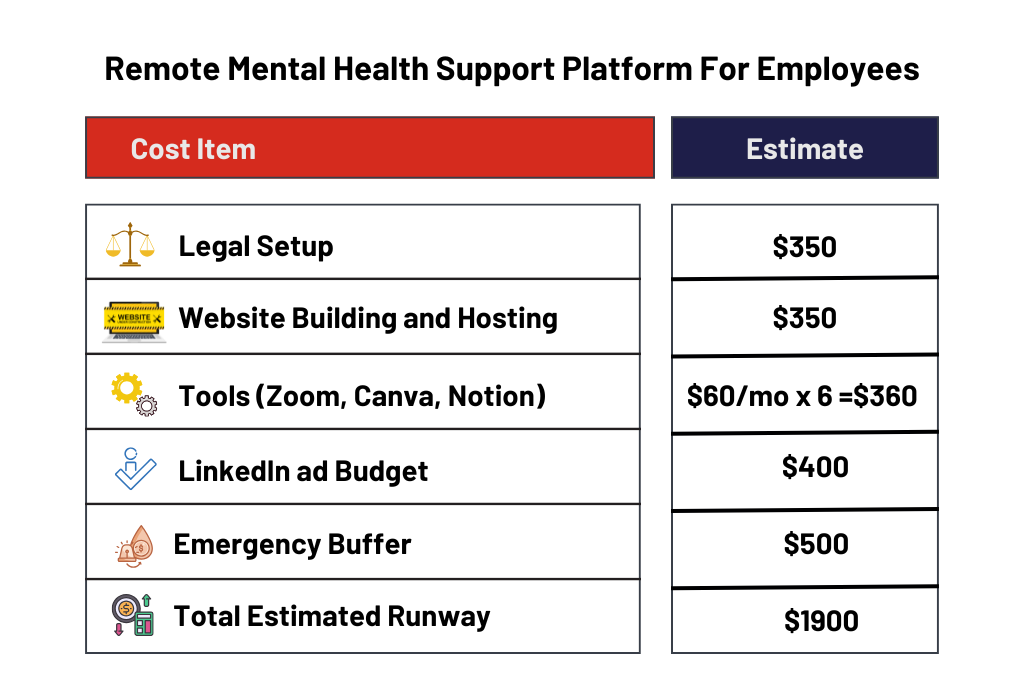
💡 Use a spreadsheet or tools like Cuttles or LivePlan to plug in your real costs, and always budget for unexpected delays.
17. Set Up Your Accounting System
You don’t need to become an accountant, but your books need to stay clean.
At minimum, track:
- Revenue
- Fixed vs variable expenses
- Profit margins
- Receipts and write-offs
- Mileage and travel
- Contractor payments
Your options:
- DIY: QuickBooks, Wave (free), Xero, or Excel
- Outsource: Hire a remote bookkeeper (hourly or dedicatedly)
- Hybrid: You handle expenses, pro handles tax prep and reporting
💡 Set a monthly reminder to reconcile everything; consistency now prevents chaos later.
18. Decide How You’ll Fund the Business
Every founder starts with this question: Where’s the money coming from?
Here are your common paths:
- Bootstrapping: Build slow and lean with savings or income
- Friends & family: Fast, informal, just use clear agreements
- Small business loans: commercial mortgages with help from KIS Finance, SBA loans, microloans, or fintech lenders like Lendio
- Grants: Local business, women/POC founder grants, startup accelerators
- Crowdfunding: Kickstarter, Indiegogo (especially for product-based businesses)
Ask yourself:
- Do I want control or growth?
- Am I selling now or building to raise later?
- Can I afford to delay profitability?
Example: A SaaS founder building an MVP might need $30k for dev + GTM. A solopreneur coach could start with under $1k.
💡 Tip: Don’t obsess over raising capital; most sustainable businesses start scrappy and build traction first.
19. Separate Business & Personal Finances
Mixing your accounts? That’s a red flag for investors, accountants, and the IRS.
Structure your setup like this:
- Business checking account for all income and expenses
- Business credit card to track spending and build credit
- Business savings account for taxes and buffer
- Payment platforms: Set up PayPal Business, Stripe, or Wise with matching business info
Great tools for this:
- USA: Relay, Mercury, Novo
- Global: Wise Business, Payoneer, Revolut
💡 Even if you’re the only person in the company, act like a business from Day 1.
20. Set Up a Payment System
Make it easy to get paid and reduce friction for clients.
Choose your system based on your model:
| Business Type | Recommended Tools |
|---|---|
| Service-based | Stripe, PayPal, Wise, Bonsai |
| E-commerce | Shopify, Square, Gumroad |
| International | Stripe + Wise, Payoneer |
| Recurring billing | Chargebee, Zoho Subscriptions, Paddle |
Be aware of fees:
- Stripe: ~2.9% + $0.30
- PayPal: Often higher for international
- Wise: Flat + transparent (best for B2B and global clients)
⚡ Automate invoices, receipts, and refund policies early; it builds customer trust.
21. Prepare for Taxes
Taxes don’t have to be scary if you stay organized year-round.
Here’s a simple system:
- Set aside 20–30% of your net profit each month for taxes
- Use a receipt tracker (Expensify, QuickBooks mobile, or Google Drive)
- Categorise expenses monthly
- Track mileage (with tools like Everlance or MileIQ)
- Know your quarterly filing deadlines (especially in the US)
Quarterly estimated tax due dates (USA):
April 15, June 15, September 15, January 15
🧠 One consult with a small business tax advisor can save you thousands in mistakes or missed deductions.
Stage 4: Brand Identity & Online Presence (Steps 22–26)
“People don’t buy from businesses—they buy from brands they trust.”
Your online presence is often the first (and sometimes only) impression people get. A sharp, credible brand builds trust, even before your first sale. This section helps you get there, with practical steps, tools, and small details most checklists miss.
22. Secure Your Domain Name
Your domain is your address on the internet. Even if you’re not ready to launch, secure it early to protect your brand.
Checklist:
- Keep it short, easy to spell, and avoid numbers or hyphens.
- Choose .com if possible, but .co, .io, .ai are fine for startups.
- Use Namechk to check domain + social handle availability.
- Avoid trademark conflicts, check USPTO (🇺🇸) or your local registrar.
Use registrars like Namecheap or Google Domains. Always enable auto-renew and consider buying the domain for 2+ years to signal legitimacy to Google.
💡 SEO Tip: Keywords in your domain don’t matter as much as they used to; focus on clarity and brandability.
Your domain name isn’t just an address, it’s your first impression, your credibility signal, and a big part of your brand story. Here’s why choosing the right one matters more than you think:
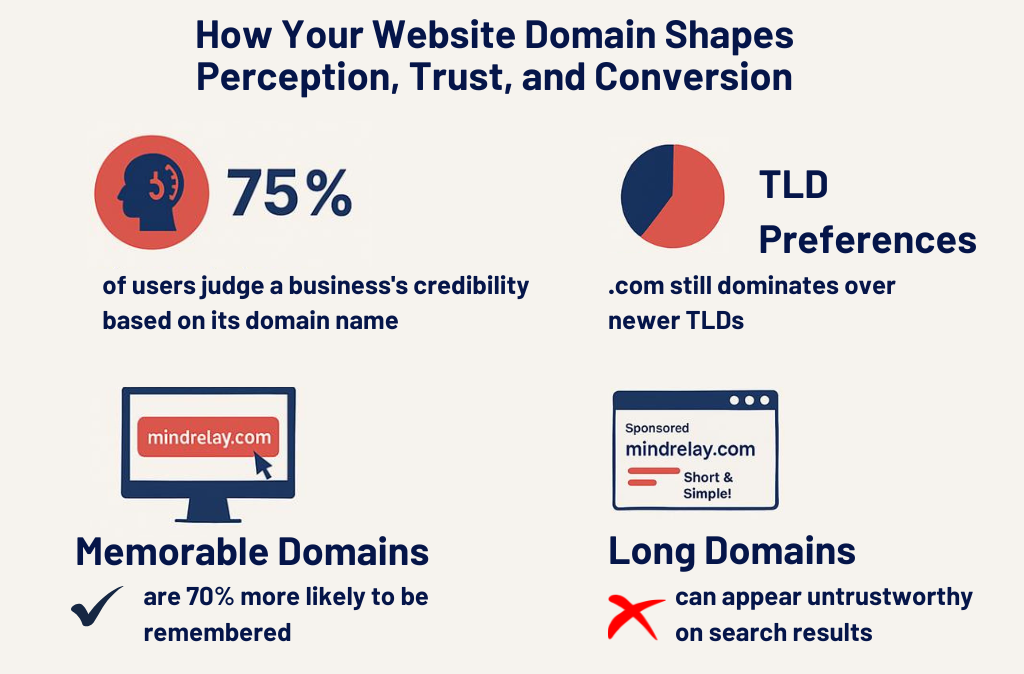
💡 Use a spreadsheet or tools like Cuttles or LivePlan to plug in your real costs, and always budget for unexpected delays.
and start operating. These steps are about delivering your offer with clarity, launching it with intent, and measuring what matters from day one.
23. Build Your Website
Your website is your digital storefront, even if you’re not selling anything yet.
Start lean. Focus on:
- Clarity: Who you help, what you do, how it works
- Action: Make your CTA clear (buy, book, subscribe)
- Credibility: Add a professional photo, contact info, and testimonials if you have any
Platform tips:
- Wix/Squarespace: Fast setup, beginner-friendly
- Webflow: Flexible + sleek (but has a learning curve)
- WordPress: Great for content-heavy businesses (pair with Elementor)
- Shopify: For e-commerce, no-brainer
- Carrd: Perfect for quick MVPs or one-pagers
Don’t forget to:
- Add Google Analytics 4 or Plausible for tracking
- Set up basic SEO (meta titles, descriptions, alt tags)
- Include a privacy policy and cookie notice (especially for EU visitors)
⚠️ Avoid slow-loading themes and bloated templates; Core Web Vitals matter for SEO and bounce rate. For designing, development, and maintenance at a budget and with expertise, consider hiring web developers offshore.
24. Define Your Visual Identity
Your visual identity makes your brand recognizable and trustworthy.
Create a mini brand kit that includes:
- Logo (text-based is fine to start)
- Colour palette (2–4 core colours using Coolors.co)
- Fonts (pair one bold with one readable)
- Visual style (clean, bold, minimal, creative?)
Use tools like:
- Canva, for brand kits + templates
- Looka or Hatchful for DIY logos
- Noun Project to find cohesive icon styles
Store everything in a central place (Notion, Dropbox, Google Drive) so freelancers, designers, or VAs can access and maintain consistency later.
💡 Brands that “look put together” get taken more seriously, even if they’re new.
25. Create Business Social Media Profiles
You don’t need to be everywhere, but you do need to be somewhere your audience hangs out.
Platform guide:
- LinkedIn: Ideal for consultants, B2B, personal brands
- Instagram: Visual-first brands, wellness, lifestyle
- Facebook: Community groups, older demographics, local businesses
- Twitter/X: Tech/startups, real-time convos, thought leadership
- TikTok: If you have video content and a personality-driven brand
- Pinterest: Great for products, planners, tutorials, DIY
Also set up:
- A Link-in-bio page with Linktree or Beacons
- Consistent profile photos, handles, and bios
- Business pages (not personal accounts) where relevant
🧠 Secure handles now, even if you’re not ready to post. You’ll thank yourself later.
26. Set Up Business Email & Phone
Trust starts with professionalism. That means no janefounder786@gmail.com.
Set up a branded email:
- Use Google Workspace or Zoho Mail
- Format: yourname@yourdomain.com
- Set up SPF, DKIM, and DMARC (email authentication records) to avoid deliverability issues, especially for marketing
Set up a virtual business number:
- Tools: Google Voice, OpenPhone, Grasshopper
- Use call forwarding, voicemail transcription, and separate work/personal inboxes
Pro Tip: Set up a catch-all inbox or shared alias like hello@, support@, or info@yourdomain.com for flexibility.
→ Common Branding & Presence Mistakes to Avoid
- Buying a fancy theme before defining your offer
- Using different profile photos or bios across platforms
- Launching ads without a clear CTA on your website
- Forgetting to add analytics tracking
- Ignoring mobile experience (most visitors will come from phones)
Stage 5: Operations & Launch (Steps 27–30)
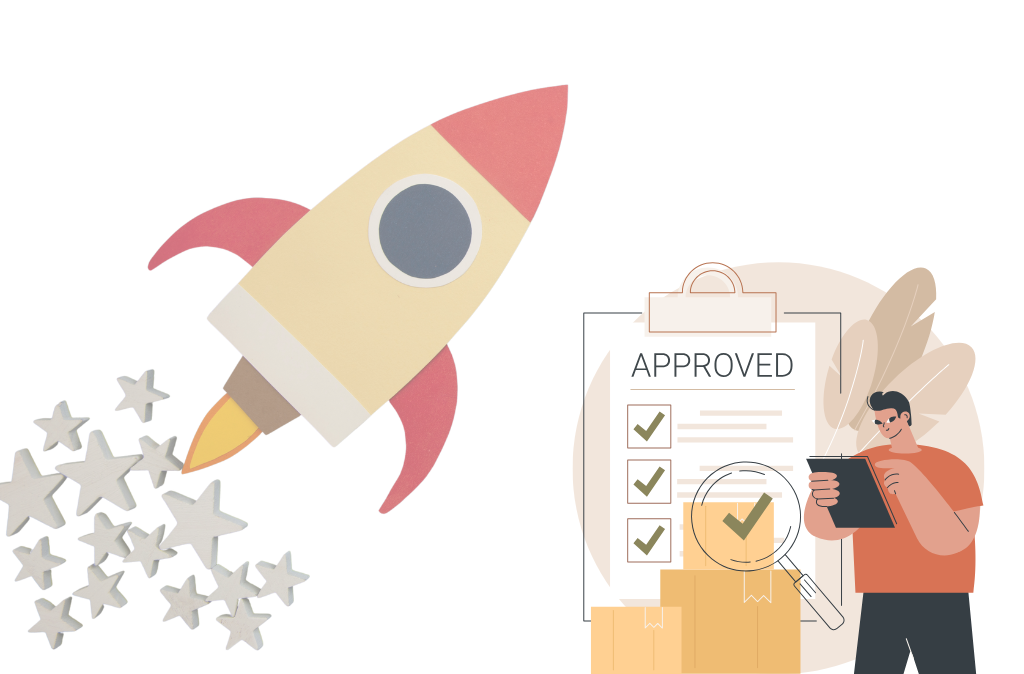
“A business becomes real when it makes someone’s life better—and earns their trust and money in return.”
This is where you stop planning and start operating. These steps are about delivering your offer with clarity, launching it with intent, and measuring what matters from day one.
27. Finalise Your Offer
This is the most important thing you’ll create and the most overlooked.
Your offer isn’t just what you sell; it’s how you position it, why it matters, and how you deliver it.
Break it down into:
- The outcome → What result do they get?
- The mechanism → How do you deliver that result?
- The promise → What makes you different?
Examples:
- “A 4-week brand strategy sprint for solopreneurs who hate marketing.”
- “Monthly mental health sessions for remote teams, backed by licensed therapists.”
- “Pre-made Notion templates for remote startup ops.”
Use this to test your clarity: “I help [who] achieve [what] using [how].”
💡 Avoid vague offers like “business coaching” or “consulting.” Get to the transformation fast.
Optional tools:
- Value Proposition Canvas
- 1-Page Offer Builder (you could create this as a lead magnet)
Use this simple framework to map your value in a way your audience instantly understands:
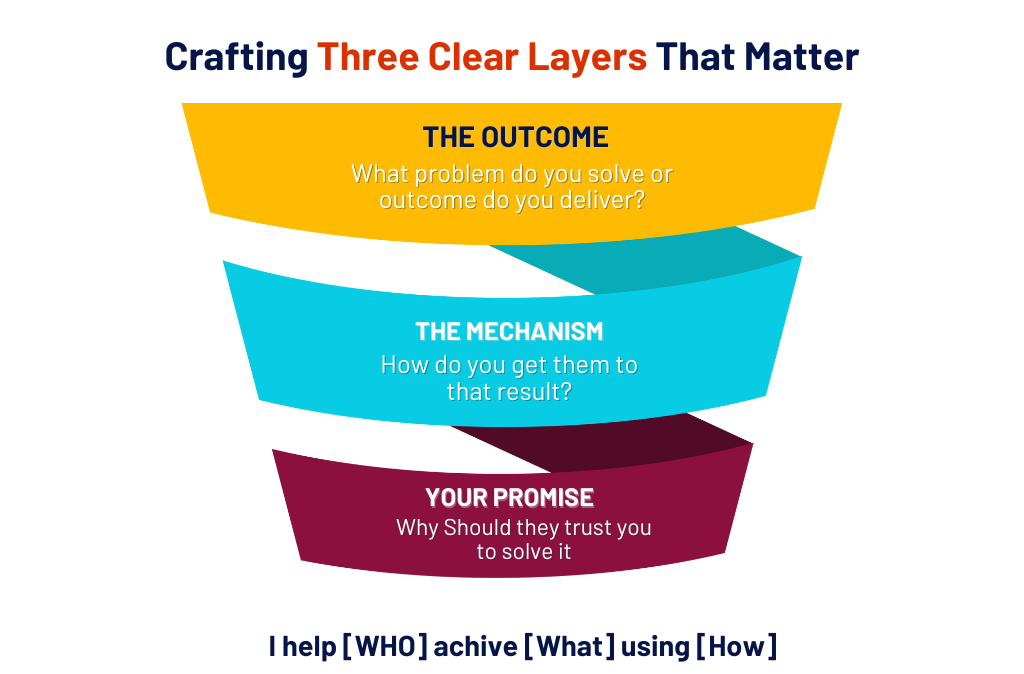
28. Plan Your Launch
A launch isn’t just for SaaS or big campaigns; it’s how you gather feedback, get attention, and create urgency.
Pick a style:
- Soft Launch: Low-pressure. Share it with friends, niche groups, early subscribers
- Beta Launch: Invite 5–20 users to test and give feedback (works great for services + SaaS)
- Waitlist Launch: Open with exclusivity. Build anticipation with a countdown or freebie
- Live Launch: Go big with a scheduled release, content blitz, and offer window (great for courses, coaching, or products)
What to prepare:
- Landing page with strong CTA
- Launch email (plus reminder/follow-up emails)
- 2–3 weeks of content (social + email + blog)
- Launch checklist in Notion, Trello, or Asana
🧠 Most launches flop because they’re vague. Your goal isn’t to “go viral”; it’s to get 10 real users you can talk to.
29. Set Up Support & Delivery Systems
How you deliver your offer and handle customers is the difference between referrals and refunds.
Think through these systems:
| Business Type | Delivery Tools | Support Tools |
|---|---|---|
| Digital products | Gumroad, SendOwl, Kajabi | Email, HelpScout, Tawk.to |
| Services | Calendly + Stripe + Notion | Gmail templates, Google Drive, Scribe |
| SaaS | App onboarding flow, Intercom | Chatbot, Notion help docs |
Checklist:
- Delivery confirmation email or thank-you page
- Client onboarding doc or welcome kit
- Support email or chat widget
- Backup plan if something breaks (like file not delivered or session missed)
💡 Even basic FAQs or Loom videos can reduce 80% of first-time buyer friction.
30. Track Performance & Learn Fast
Your first 30–60 days aren’t about scaling. They’re about learning, adapting, and building trust.
Track what actually matters:
- How many people visited?
- Where did they come from?
- What did they click?
- Did they buy, sign up, or ghost?
Tools to start with:
- Google Analytics 4 or Plausible
- Stripe + payment receipts
- Simple funnel spreadsheet:
Visitors → Leads → Trials → Sales
Ask every early user:
- “What made you sign up?”
- “What almost stopped you?”
- “Would you recommend this? Why or why not?”
Use Typeform or Google Forms to collect feedback. Keep it short and honest.
🧠 The goal isn’t perfect metrics; it’s momentum and learning. What you do next matters more than what you got right on day one.
You’ve done the hard part!
If you’ve read this far or even just skimmed and saved, congrats! You’re already ahead of most would-be founders who stay stuck in “planning mode” forever.
You’ve now got a complete, 30-step roadmap to go from idea to launch, with the legal setup, financial foundation, brand presence, offer clarity, and operational tools to make it real.
This isn’t a “read once and forget” type of guide. It’s your go-to reference when:
- You’re stuck on your next move
- You’re revisiting your launch checklist
- Or you’re hiring help to scale it all
Congrats on making it this far. That alone puts you in the top 10% of action-takers.
Need Help Putting It All Together?
Building a business is one thing. Running it efficiently is another. That’s where Invedus steps in.
We help founders, startups, and SMEs grow faster and smarter by giving them access to high-quality virtual employees and remote teams, from researchers and designers to accountants, developers, and support reps.
- You get top-tier talent without the overhead
- We handle sourcing, vetting, onboarding, and HR
- You focus on strategy, we handle the operations
Whether you need a virtual assistant to manage your inbox, a remote accountant to handle taxes, or a full-stack developer to build your MVP, Invedus can help you scale without stretching thin.
You don’t need to have it all figured out. You just need to take the next step. Now you’ve got the roadmap and a partner if you want one.
Let’s build something real.
🌍 Serving businesses across the US, UK, Europe, and beyond. Contact us to find out how we offer customized virtual employee and outsourcing services to startups in the USA, UK, and Europe.
